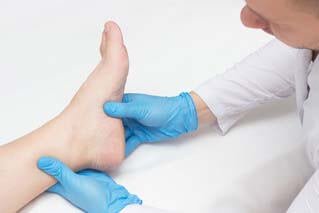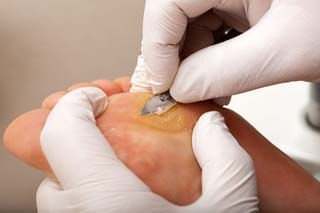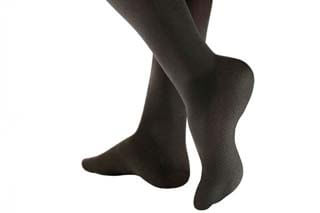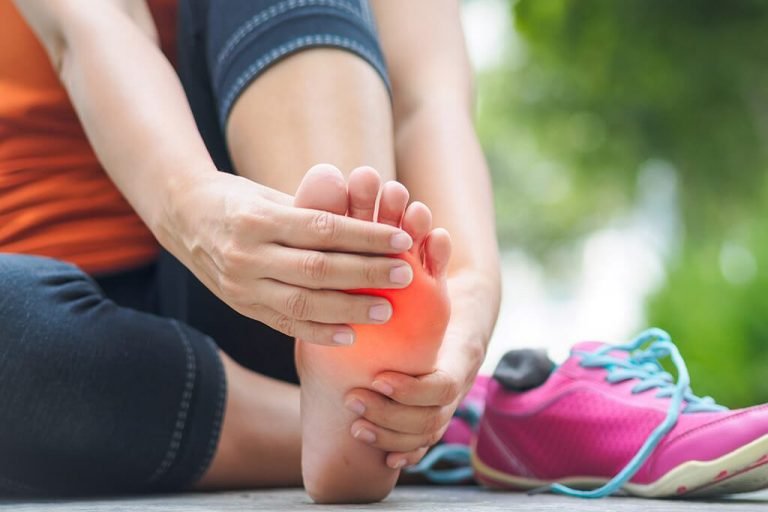What We Do Best in Caledon, Ontario
End Foot Pain For Caledon Residents!
Declaring we “end foot pain” is more than just a catchphrase or a nice slogan for us—it’s a commitment we make to you and your loved ones. Our Caledon Foot Care clinic wants to make it as smooth and easy as possible for you to be able to live the life you want without pain.
Caledon - Achilles Tendinitis Treatment – FAQ
- Trauma
- Overuse of the affected leg/foot
- Improper stretching/strengthening techniques
- Biomechanical abnormalities (i.e. flat feet)
- Improper footwear
If home treatment such as icing and rest does not alleviate symptoms, it’s time to see a foot specialist. When left untreated, tendinitis can become a chronic injury (tendinosis) which is a lot harder to treat in comparison to an acute injury (tendinitis)
- Physical examination of the legs, ankle, and feet
- X-rays /ultrasound / MRI
- Orthotics, Ankle Braces
- Foot immobilization
- Prescription of topical/oral medications to ease pain and swelling.
- Stretching / Strengthening Exercises
- Custom orthotics to control foot motion
- The gradual build-up of activity level
Caledon - Arthritis Treatment – FAQ
- It is a term used to describe over 200 rheumatic diseases and refers to inflammation and swelling of the joint. However, the most common form of arthritis is osteoarthritis (we will be focussing on this condition below) which refers to the breakdown of joint cartilage over time due to wear and tear.
- The prevalence of arthritis increases with age.
- Genetics / Heredity
- Injuries (especially untreated injuries); overuse
- Biomechanical abnormalities
- Obesity
- Aging
- Dull aching pain
- Joint stiffness / tenderness
- Decreased joint range of motion
- Palpable bone spurs
- Grating sensation
Recurring pain, swelling of one or more joints, redness or heat in a joint, limited joint range of motion, and joint stiffness (especially in the morning) are all signs of some form of arthritis that can affect structure and function of your feet and should seek treatment.
- Physical examination of the legs, ankle, and feet
- Patient education
- Physical therapy (Laser / Ultrasound treatment)
- Prescription of topical or oral medications
- Implementing exercise programs
- Steroid injections
- Orthotics
- Surgical intervention referral
Correct any fault foot biomechanics that lead to abnormal joint movements through orthotics or other forms of correction and routine exercise regimen
Caledon - Bunions Treatment – FAQ
- The first toe joint plays a significant role during walking/running and is responsible for carrying a lot of the body’s weight while in motion.
- When the bone or tissues associated with the big toe joints move out of place a “bump” begins to form at the metatarsophalangeal (MTP) joint (base of the big toe).
- The big toe is forced to bend towards the 2nd toe causing the prominent lump of bone.
- A similar presentation can appear on the outside of the foot at 5th toe called a Tailor’s Bunion. (Bunionette)
- Genetics / Heredity
- Trauma / Injury
- Biomechanical abnormalities (i.e flat feet)
- Abnormal pressure
- Improper footwear (i.e. heels)
- Neuromuscular disorders
- Corns / Calluses
- Swelling
- Pain
- Redness
- Firm bump on the outside edge of the 1st toe joint
- Restricted motion at the big toe joint
- Persistent pain is an indication that podiatric medical attention is necessary
- If untreated, bunions tend to get bigger and more painful making non-surgical treatment less of an option.
- However, even if presentation is there but asymptomatic, early treatment is always the better option.
- Physical examination of the legs, ankle, and feet.
- Padding / Taping techniques
- Medication to ease pain and inflammation
- Manipulation (FMT) / Ultrasound / Laser Therapy / Acupuncture
- Bunion night splints or silicone toe spacers
- Orthotics and Orthopedic Footwear
- Surgical Correction referral
- Early treatment is always the better option to attempt to halt the progression of the bunion formation.
- Wear shoes that have wide and deep toe boxes to accommodate your foot properly.
- If you are an individual with excessive flat feet, wear supportive shoes and get custom orthotics from your Chiropodist / Podiatrist if necessary.
Caledon - Heel Pain Treatment – FAQ
- The calcaneus (heel bone) is the largest and strongest bone of the foot, however, it is not immune to problems.
- Pain in the heels can present in the bottom, front or back of the heel.
- Pain in the heels is most commonly caused by plantar fasciitis (for this reason we will focus on this condition below).
- Plantar fasciitis is the inflammation of the band of tissue on the bottom aspect of the foot as a result of the tear/stretch of the fascia along its length (heels to the ball of the foot).
- Faulty biomechanics (i.e. gait abnormalities, flat feet, high arches, etc.)
- Excessive heel pressure
- Athletes
- Improper footwear that lacks foot support
- Pain at the heel and arch area
- Swelling in the most tender point
- Pain with the first few steps upon awakening or weightbearing after prolonged sitting
If any of the following symptoms above are present and it limits your normal daily activities, contact your foot specialist. (Chiropodist / Podiatrist)
- Physical examination of the legs, ankles, and feet
- Padding, Taping and Strapping
- Physical therapy (Laser / Ultrasound treatment / Acupuncture)
- Prescription of topical or oral medications to ease pain
- Implementing stretching / strengthening programs once acute symptoms are treated
- Orthotics and footwear modification
- Steroid injections
- Surgical intervention (rarely necessary)
- Wear shoes that accommodate your foot well.
- Stretch before and after exercising
- Practice good nutrition and rest
- Exercise and lose excessive weight
Caledon - Ingrown Toenail Treatment – FAQ
- Nail corners/sides of the nails abnormally curve and dig into the soft tissue of the nail grooves causing pain.
- Although the smaller toes can be affected, more commonly seen in the big toenail.
- Genetics / Heredity
- Pressure from shoes
- Crowding of toes
- Recurring trauma to the feet from normal activities
- Incorrect clipping of the toenail
- Pain
- Swelling
- Redness
- Drainage (Clear fluid or Pus)
- Odour
- Thickened surrounding skin or highly vascularized skin that keeps bleeding
- If any of the following symptoms above are present and no improvements are noted with home treatments.
- Individuals with poor circulation, diabetes, etc., seek immediate treatment as soon as symptoms become present.
- Physical examination of the affected nail(s)
- Non-surgical removal of the ingrown portion of the nail (depending on severity).
- Permanent surgical correction of the ingrown portion of the nail to prevent a recurrence.
- Prescription of topical/oral medications to treat the infection.
- Trim nails straight across making sure nails are not longer than the toe tip.
- Do not round or dig into the corners with a nail file or any other device.
- Wear shoes that have wide and deep toe boxes to accommodate your foot properly.
- Never rip or tear nail edges.
Caledon - Morton’s Neuroma Treatment – FAQ
- Tingling, burning or numbness.
- Pain.
- A feeling that something is inside the ball of the foot.
- A feeling that there is something in the shoe or a sock is bunched up.
It seems to develop as a result of irritation, pressure, or injury to one of the nerves that lead to the toes; this triggers a response, resulting in thickened nerve tissue (neuroma). A high percentage of patients with Morton’s neuroma are women who wear high-heeled or narrow shoes. Other conditions such as hammer toes, bunions, and swelling in the foot can flare up neuromas.
Options for treating Morton’s neuroma include changing shoe type, using custom made orthotics or metatarsal pads, taking nonsteroidal anti-inflammatory drugs (NSAIDs), giving corticosteroid or sclerosing alcohol injections, and surgically excising or transposing the offending nerve.
Treatments from a Chiropodist / Podiatrist, may include: specially made soft pads, silicone spacers or Orthotics – to take the pressure off the painful area of your foot. Painkilling injections, non-surgical treatments – such as manipulations (FMT), LLLT (therapeutic laser therapy), acupuncture and footwear modification.
Surgical recovery is longer for a neurectomy, ranging from 1 to 6 weeks, depending on where the surgical cut is made. If the incision is at the bottom of your foot, you may need to be on crutches for three weeks and have a longer recovery time.
Caledon - Custom Made Foot Orthotics – FAQ
Orthotics are an insert made for your shoes that help properly align and support your feet, knees, and back. Specifically designed and customized for the size and shape of your own feet but made to specific prescription to address the abnormal biomechanical issues of your feet and gait.
Wearing orthotics help realign your entire body, providing the joints and muscles a chance to perform the action they are meant to, in turn increasing strength over time and relieving the pain you may be experiencing.
There are many reasons why one may require an orthotic. For example flattened arches put pressure on not only your feet but other areas of your body as well (knees, hips, lower back, and upper back). As a result, you may experience pain in these areas at some point in your life.
Some of the reasons Orthotics can be used for treatment and prevention of:
- Bunions (Hallux Abductovalgus)
- hammer toes / clawed toes
- bunionettes
- heel spurs/ arch pain and heel pain (plantar fasciitis)
- Achilles pain (Achilles tendonitis)
- Arthritis (osteoarthritis, rheumatoid arthritis, psoriatic arthritis)
- Nerve pain / sharp pain in the toes (Morton’s neuroma )
- Pain in the ball of feet (metatarsalgia)
- Flat feet (pes planus) / high arches (pes cavus) / into gait (seen commonly in children)
- Knee pain (patellar femoral syndrome / Osgood Schlatter / knock knees, bow-legged knees)
- To prevent the occurrence of calluses, corns, and even ingrown toenails
- Children toe walking
- Lower back pain
- Ankle pain or ankle instability
- Stress Fractures
- Diabetic foot complications
Podiatrist / Chiropodist is the primary health provider/foot specialist who is extensively trained to assess and diagnose your foot pathologies. Creating a suitable orthotic based on your foot condition requires extensive knowledge and training. 26 bones, 33 joints, 107 ligaments, and 19 muscles make up the foot! Podiatrists and Chiropodists always use accredited labs to create your custom orthotics/insoles and therefore your orthotics are truly custom and will never receive ones that are “prefabs or off the shelf”.
We encourage follow-up visits and annual check-ups to ensure everything is working as it should be!
Biomechanical assessment and gait analysis leading to a diagnosis.- Footwear Assessment- Consultation on what is needed- Casting / Foot Impression for orthotics to be made (Plaster casts, 3D Scanner, Laser Technology etc.)
Caledon - Stress Fracture Treatment – FAQ
Unlike a fracture caused by an obvious injury, a stress fracture involves a small crack in the bone as a result of the amount of stress put on a particular bone of the foot exceeding the body’s ability to adapt to it. All weight-bearing bones of the foot can be prone to a stress fracture, however, this injury is most commonly seen at the metatarsals (the 5 long bones in the foot).
Studies show that females are more prone to stress fractures in comparison to their male counterparts. This may, in part, be due to the “female athlete triad” which states that when a woman participates in sports, she may be more prone to 3 illnesses: eating disorders decreased bone mineral density and dysfunction of the menstrual cycle. As a female’s bone mass decreases, the chances of getting a stress fracture increases.
- Significant pain with activity
- Swelling with possible bruising
- Tender to touch the site of the fracture
- Difficulty wearing shoes
- Although some stress fractures present with many of these symptoms, certain cases may have no signs other than slight swelling of the fractured area.
If any of the following symptoms above are present, seek treatment, as a fracture that fails to heal (non-union) or heal properly (malunion) may require surgical intervention.
- Thorough discussion of your medical history, general health, work, activities, diet, and medications to identify risk factors that you have for a stress fracture.
- Physical examination of the legs, ankles, and feet
- Padding / Taping techniques
- Footwear modification / immobilization techniques / air cast
- Medication to ease pain and inflammation
- Treatment using therapeutic modalities (Laser, acupuncture )
- Custom made orthotics
Recovery ultimately depends on the severity of the fracture, however, most stress fractures heal within 6-8 weeks. One of the most common mistakes people make is returning to activity too soon. Being sidelined with an injury can definitely be frustrating, but returning to activity too soon puts you at risk for larger, harder to heal stress fractures that can be taken even longer to heal. It is important to confirm with your Chiropodist / Podiatrist that full healing has occurred before returning to activity. Slowly increase the intensity, duration, and frequency of the activity with lots of rest in between to give your bone time to adapt to the new demands placed on it.
- Eating a healthy balanced diet that is rich vitamin D and calcium to increase bone strength
- Avoiding shoes that are worn out and/or do not match your foot type. Stiffer outer soles with softer insoles are two key features to look for in shoes if you have a history of stress fractures.
- Avoid a sudden increase in activity.
- Alternate between high and low impact activities to avoid overstressing one area of the body. For example, running one day followed by cross-training the next day (i.e. swimming).
Caledon - Toenail Fungus Treatment – FAQ
- Onychomycosis (toenail fungus) is a fungal infection underneath the surface of the nail.
- Often begins at one toenail and spreads to other toenails and the skin over time.
- Fungal nails often appear thick, yellow and crumbly.
- Barefoot walking (especially in bathing facilities, swimming pools, locker rooms etc.)
- Nail bed injury
- Conditions that cause immune deficiencies (i.e. diabetes)
- Excessive perspiration or exposure of toes to dark moist environments (i.e. shoes)
- Nail salons where proper sterilization techniques are not enforced
- Poor foot hygiene
- Often present for years with no pain or any other symptoms.
- Other times due to its thick nature can cause pressure, bacterial infection or ingrown toenail pain
Any abnormal nail presentation should be assessed by a Chiropodist / Podiatrist. Earlier treatment = greater chance of clearing infection
- Physical examination of the toe nail
- Nail culture
- Debridement of the nail
- Prescription of topical meds / Fungal laser therapy
- Surgical intervention
- Practice good foot hygiene.
- Change shoes/socks more than once daily.
- Disinfect instruments used to cut nails at home.
- Wear moisture resistance socks.
- Wear flip-flops in public facilities such as swimming pool decks, change rooms, and public showers
- Don’t wear the same shoes back to back and if necessary use a fungicidal shoe spray to disinfect any traces in the footwear
- If your feet are prone to sweating – use powders specific to feet
Caledon - Warts Treatment – FAQ
- A soft tissue lesion caused by an invading virus and most commonly appearing on the sole of the foot.
- Usually presents as a well defined elevated lesion with embedded black dots and cauliflower appearance.
- More commonly seen in teenagers and children.
- Small cuts or breaks in the skin
- Barefoot walking (especially in dirty surfaces, bathing facilities etc.)
- Contact with skin shed from other warts
- Sharp or burning pain
- Inability to wear shoes
- Bleeding
- In some no pain
Any suspicious growth on the skin should be assessed by a Chiropodist / Podiatrist. If left untreated, warts can increase in number, grow bigger in size and/or spread to other areas. Although rare, more serious lesions can be misidentified as a wart (i.e. melanomas) and other times warts are misidentified as just callus or corn.
- Physical examination
- Shaving down the overlying dead skin / callus
- OTC or prescription wart-removal preparations.
- Surgical removal of the wart under local anesthetic (via various techniques that best suits your lifestyle: excision, laser removal, needling)
- Avoid barefoot walking.
- Shoes and socks changed daily.
- Practice good foot hygiene.
- Check feet daily.
- Avoid contact with warts.
- Annual foot check-ups

Caledon Foot Care Professionals

Get Foot Care Solutions

Advanced Foot Care Technology
With the vast experience and solid background, Foot Clinic & Orthotics has all of your foot care needs covered. We employ the most modern techniques, using the most modern and safest technology to bring the best foot care to your health.

Care & Pain Management

Caledon Custom Orthotics

Compression Stockings

What is Custom Bracing?
A custom brace is a personalized brace worn to stabilize the ankle. It is worn around the ankle, and works by relieving pressure from the part of the ankle joint affected by diseases, injury or general ankle instability. Our qualified staff is highly trained to provide you with a vast assortment of both custom and off the shelf bracing options. We specialize in Bauerfeind, Donjoy, custom Ritchie Brace and Airzona Brace.

What is Orthopaedic Footwear?

How do you treat diabetic feet?
Experienced & Certified Foot Care Team
Hasinah Shaqiq, Hons. B.Sc, D.Pod.M
Jessica Rew, Hons. B.Kin, D.Ch.
Jessica Rew is a fully licensed chiropodist who is registered with the College of Chiropodists of Ontario and is an active member of the Ontario Society of Chiropodists. Jessica’s interest in healthcare was initially peaked while obtaining her Honours Bachelor of Kinesiology Degree at Brock University.
Following the completion of her undergraduate degree, she pursued her interest in healthcare by gaining knowledge and experience in the field of physiotherapy by working alongside physiotherapists as a physiotherapy assistant in a private clinic. Through this experience, she saw the importance of foot health and the impact it can have on one’s quality of life.
This experience led to her enrollment in the Chiropody program at the Michener Institute of Education at UHN. During this time, she gained clinical expertise from various hospitals, community health centers and private practices. One experience to highlight in particular was her time at the Ottawa Hospital, this opportunity allowed her to develop advanced wound care skills and the ability to treat high-risk patients with ease.
In conjunction with working at FCO – Foot Clinic & Orthotics, Jessica also works at St. Michael’s Hospital in Toronto as a practitioner in one of their family health team clinics. Jessica is looking forward to helping you with any foot care needs you may have. She is currently practicing out of both the Caledon and Kleinburg clinic sites.
We Will Help You Every Step Of The Way
What Our Patients Say About Us
Attention Local Caledon Residents
Are you among the many who have ignored their feet for too long?

Start Everyday on the Right Foot
You take about 4000 steps a day. Without the right support, those steps can start to get uncomfortable or even painful. Foot orthotics are designed to support, align and improve the function of your feet and lower limbs while walking or participating in physical activities.
Get Effective Orthotics in Caledon


Custom Orthotics Can Help Relieve Pain Caused By These Conditions
- Achilles tendonitis and Plantar Fasciitis (heel pain)
- Metatarsalgia and Nerve pain (morton’s Neuroma)
- Pronation (flat feet)
- Supination (high arch feet)
- Bunions, Clawed Toes and Hammer Toes
- Dysfunction, Shin pain and Knee problems
Get Custom Made Foot Orthotics in Caledon
At Foot Clinic & Orthotics, we conduct a thorough assessment before making any orthotic recommendations.
Our assessment includes:
- Biomechanical Assessment: Which assesses your range of movement, gait and function.
- Pathological Assessment: We determine if there are any other physical factors that might be causing foot abnormalities, such as injuries, specific health conditions, your job, and lifestyle
- Footwear Analysis: Your footwear will be evaluated, and recommendations will be made for shoes that provide you with the right support
Almost all insurance companies will accept an Orthotic prescription from the Chiropodist / Podiatrist, but some may require one form your Medical Doctor. It is recommended to find out what your insurance prefers prior to booking an orthotic assessment.
The orthotic prescription should take into account the above three considerations in order to determine what you’ll need. We will help you choose the right material (plastic polymer, EVA or carbon fibre) that will provide you with the right support. For patients with sensitive foot problems, including elderly or people with serious injuries (such as ulcers), softer, more flexible orthotics will be made to provide support without causing further pain to already sensitive areas. For serious conditions which require ankle and foot support, customized orthotics can be made more rigid to provide a functional change and support. Once we’ve done the assessment and prescribed your orthotics, we send your order off to the lab to be made.
Orthotics can be made specific to types of activities: skate, ski, soccer, basketball, sprinting, golf, or specific to types of footwear: casual orthotics, sports orthotics, dress orthotics.
Once your custom orthotics come back from the lab, we will book you in for a fitting session for your orthotics to be fitted and dispensed by one of our licensed Chiropodist / Podiatrist. At this session, we will make sure that the orthotics fit properly in your shoes and to your feet and walk you through your first few months of wear. We will also bring you back in at the one month and 3-6month mark to make sure the orthotics are working the way they’re supposed to.

We believe that everyone deserves to feel better!
Caledon Clinic
- 15955 Airport Road, #202 Caledon East, ON L7C 1H9
- 905-860-1600
- 905-860-1602
- [email protected]
Nobleton Clinic
- 13196 Hwy 27, Nobleton, ON L0G 1N0
- 905-552-3668
- 905-552-3669
- [email protected]











